Nerine: planting and care at home

Today, flower growers have the opportunity to cultivate a large number of flowering crops that thrive in the garden, as well as on window sills indoors. These plants include nerine. The flower is deservedly popular, because it is presented in a variety of species and varieties, distinguished by incredibly beautiful flowering.
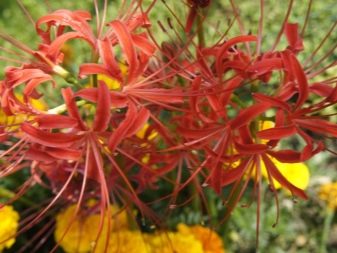
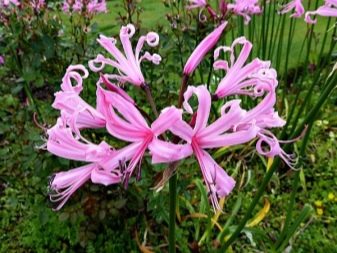
Description of the flower
The culture belongs to bulbous perennials from the amaryllis family. Today, several names for this beautiful flower can be found, besides nerine, the plant is also called spider lily, sea nymph, cape flower and Guernsey lily. In the wild, the plant grows in South Africa. Nerine has flat foliage of a linear type, colored deep green. The diameter of an adult bulb usually does not exceed 5 centimeters. The buds are formed on a peduncle, which can reach 40-50 centimeters in length. An inflorescence is located on a thin stalk, consisting of several small funnel-shaped buds.
Nerine blooms with flowers, the diameter of which in the open state does not exceed 4-5 centimeters, while, depending on the species, they can have white, pink, orange or red color. The petals are rather narrow with a wavy edge. Typically, the flowering period of the plant falls in September and October.
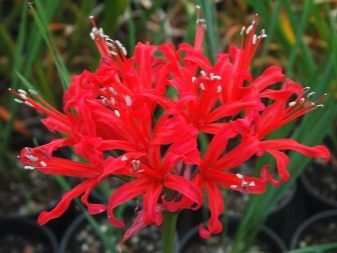
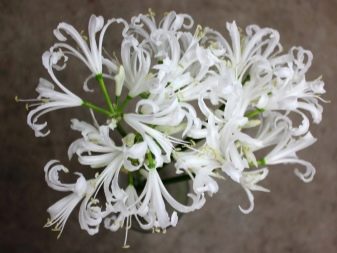
In the conditions of the Russian climate, the flower is most often grown indoors; in the summer, flower growers can leave the culture in the fresh air, on open verandas, and so on. As for regions with a milder climate, the plant is quite capable of overwintering in the open field.
Florists who plan to grow a flower are advised to be careful, since the spider lily sap is poisonous. It is dangerous not only for humans, causing burns to the skin and mucous membranes, but also for pets.
Therefore, in the room, you should carefully consider the place for placing the culture. With careful care and creating optimal conditions for growth and development, nerine will delight the grower with regular beautiful flowering.

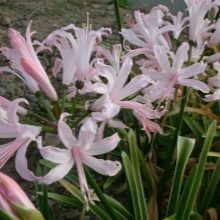
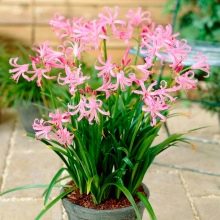
Views
In the genus of bulbous perennial, there are about three dozen species. Among the most popular are several crops.
Nerine Bowden
The plant has belt-like foliage and a slightly elongated bulb, which can be partially on the surface. The green mass can reach a length of 25-30 centimeters with a width of 2-3 centimeters, there are veins on the glossy surface. At the end of the peduncle there are umbrella-type inflorescences, consisting of 5-10 flowers with curved petals. The species blooms with flowers that have all shades of lilac.
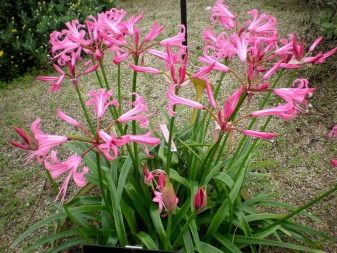
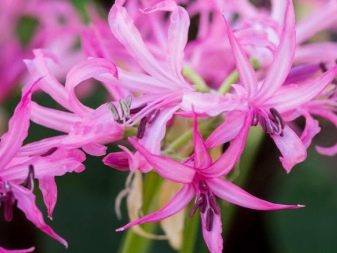
Nerina is shy
This variety stands out with a small number of white flowers on the peduncle. As a rule, their number does not exceed 5-6 pieces. The leaves are elongated and have a minimal bluish tint.
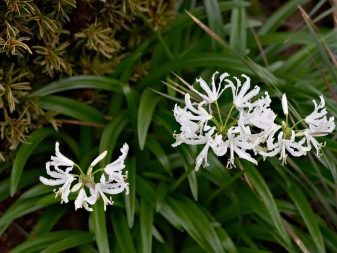
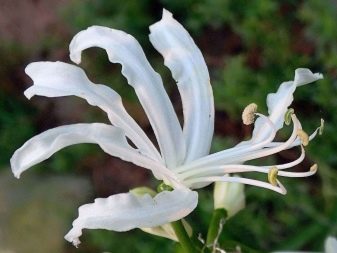
Nerine twisting
The plant is rarely grown at home by flower growers. The culture is notable for its flowering, during which bell-shaped flowers with corrugated edges ripen on the peduncles. The color of the buds ranges from white to pale pink.
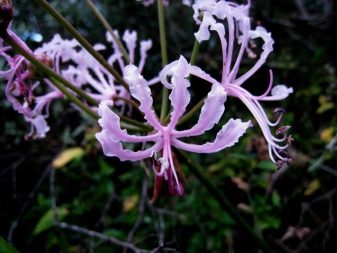

Nerine sarneiskaya
In this species, the flowers are large, the petals, as a rule, have slightly curled edges. The flower can bloom with white, orange or red inflorescences.
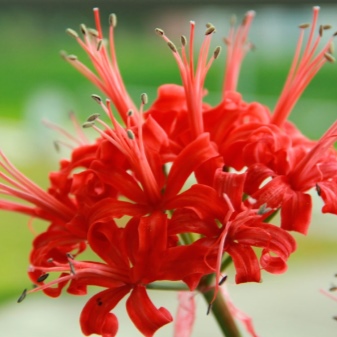
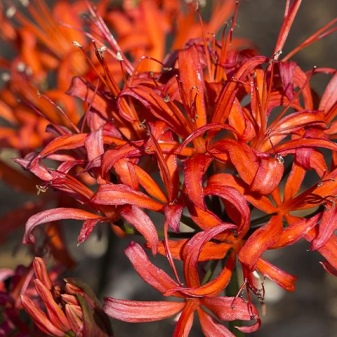
Nerina narrow-leaved
Outwardly, this species differs in the structure of its leaves. On the peduncle, flowers of a lilac-pink color are formed.
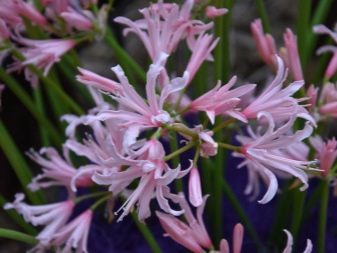

Nerina Hutton
A beautiful culture that stands out for its lush bloom. Many small pink flowers usually develop on the peduncle.
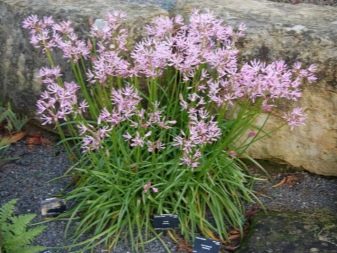

Nerina wavy
A flower with straight leaves, red or pink buds on a peduncle, most often their number is about 8-10 pieces.
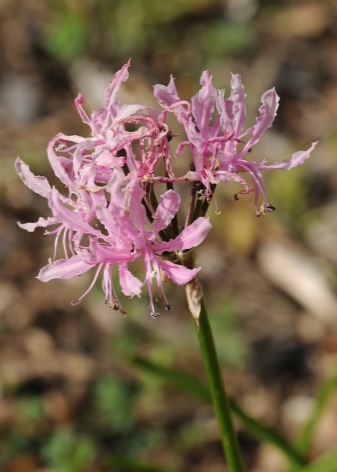

Nerina is low
The formation of foliage in a plant occurs simultaneously with the development of a peduncle. One leg grows from one to two dozen flowers with pink or red petals.


Nerine curved
The green mass does not stop growing even during the flowering culture. The spider lily blooms in large flowers with a scarlet color of glossy petals.
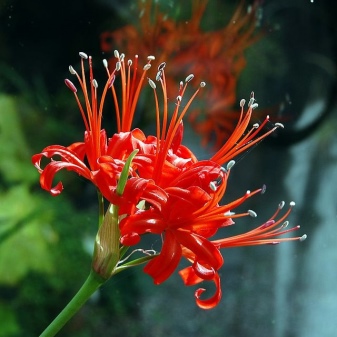

Landing rules
Bulbous culture can be planted in pots in several pieces. However, the diameter of the container chosen for growing should not be less than 12-14 centimeters. Some growers prefer to root nerine in even larger pots, planting the plant in a circle, with the cultures removed from each other by 3-4 centimeters. In this embodiment, the flower will not give offspring, but will actively bloom. The plant should be planted in the ground in such a way that part of the bulb remains on the surface.
A perennial requires a loose and light soil with a slightly acidic environment. You can make such a soil mixture yourself by mixing sand, humus and sod soil in equal parts.
For proper development, the plant will need a drainage layer at the bottom of the pot.

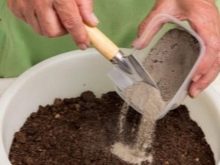
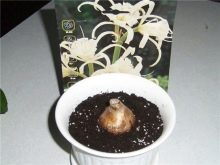
Care features
The rules regarding crop care will depend on the life cycle in which the nerine is found. This is directly related to the season. It is worth highlighting the basic care recommendations for each period.
- In winter the plant is laying flower buds, at this time the culture requires coolness and dry air. The flower should be kept at a temperature of about + 10 ° C. For these purposes, flower growers often send the plant for the winter to the basement or to the loggia.
- With the arrival of spring, around March, the container with a flower can be carried to a lighted place in the room. During this period, the culture will increase its green mass. Watering should be moderate.
- Summer nerine enters a resting phase, in which it is necessary to remove dried green mass from it, and also gradually reduce moisture. The optimum room temperature during this period will be in the range of + 23.25 ° C. Closer to August, the moment comes when the plant will need moisture and feeding, as the flower is preparing to bloom.
- In September the plant begins an active growing season. The flower grower must ensure good watering, as well as the introduction of fertilizers every 2 weeks. This is especially true of the time when a flower appears on the peduncle. For nerine, complex mineral formulations are suitable, which are best used in liquid form. The air humidity should not be increased; it is also worth protecting the culture from direct sunlight.
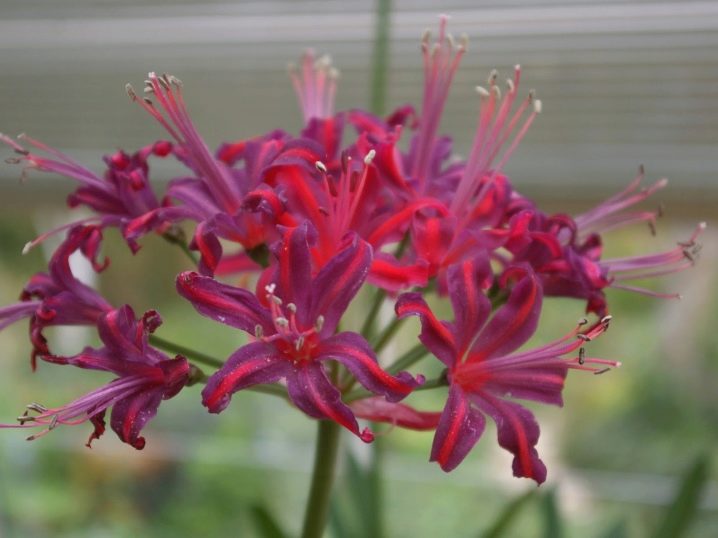
The plant adapts for a very long time after transplanting, so it is not necessary to replace the container too often.
To replace the soil, only the top layer of soil in the pot can be removed, replacing it with a fresh one. It is best to carry out these works in summer or spring. The flower will be ready for transplantation only upon reaching 3 years of age.
Reproduction methods
Today, 2 methods of obtaining new bulbous flowers are actively practiced:
- reproduction by seeds;
- daughter bulbs.
Seeds
The first option involves sowing seeds in small containers or shallow containers with soil. Vermiculite will be a suitable substrate for planting. Due to poor germination, the harvested material must be deepened shortly after harvest., while it is necessary to distribute it one by one with a distance of 2-3 centimeters from each other.After planting, the seeds and soil are moistened with a spray bottle, then the crops are covered with glass or film, providing the planting material with a temperature of at least + 22 ° C and regular ventilation. Viable seeds, under the right conditions, will sprout in 2-3 weeks. It is possible to plant young plants in separate containers at the moment of appearance of several leaves on the stem.
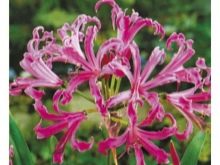
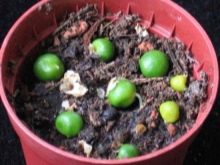

Bulbs
Removing the bulbs from the mother plant is best done in the spring, combining this work with a transplant. The process itself involves the extraction of the rhizome, as well as the careful separation of small bulbs, which will have their own roots. They are immediately transplanted into separate containers with soil, caring for them as if they were an adult culture. For the bulbs, you will need small pots in diameter.

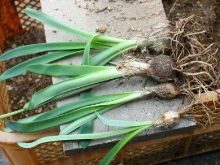
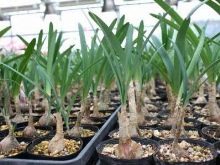
Disease and pest control
Among the most dangerous ailments from which nerine suffers, several are worth highlighting.
Powdery mildew
Fungal infection, a sign of which is a light bloom on the green mass of the culture. If such neoplasms are found on the leaves, nerin should be treated with store-bought fungicidal compounds.
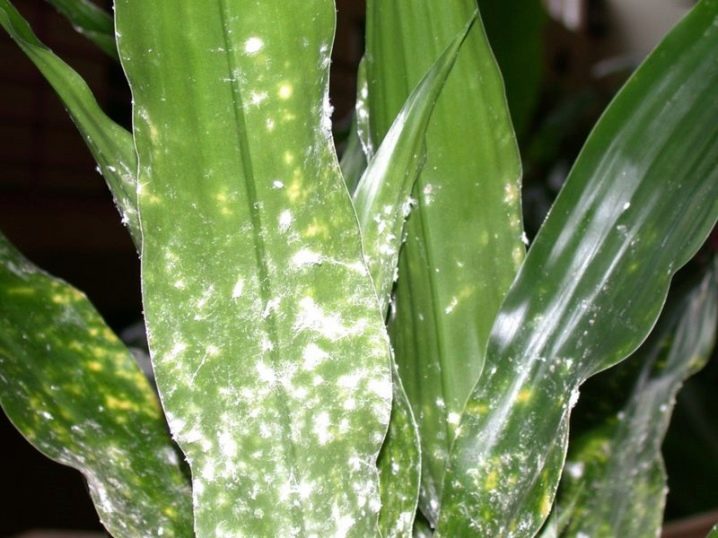
Mosaic virus
A dangerous disease, the signs of which will be brown spots on the leaves of the flower. Most often, the disease develops due to mistakes related to caring for the plant at home. Florists fight the disease with fungicides.
Florists fight the disease with fungicides.
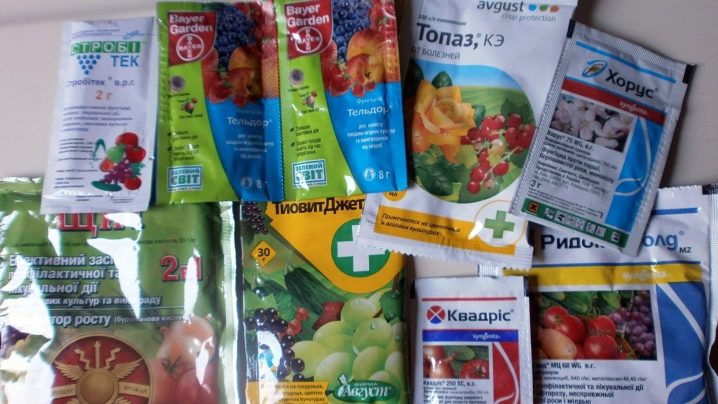
Excess moisture can lead to the death of a plant, therefore, the amount of injected liquid should be strictly controlled, avoiding stagnation in the pot. Otherwise, the bulb will start to rot.
Among insects that pose a danger to culture, it is worth highlighting a number of individuals.
Mealybug
A small insect that feeds on the sap of the culture. Finding a pest on a plant can be difficult given its small size. A sign that indicates the presence of a worm is black mold on the leaves. The fight against dangerous insects is carried out by treating the plant with phyto-compositions, however, the florist will first need to manually collect individuals from the culture, using a cotton swab dipped in alcohol for this purpose.
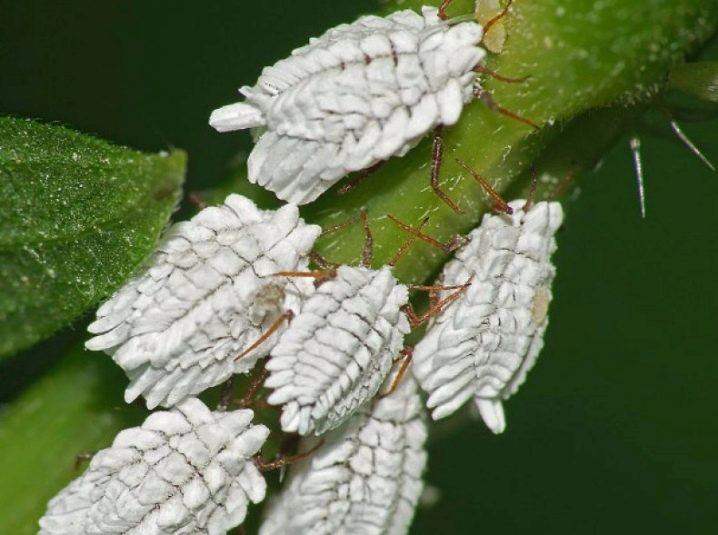
Aphid
A dangerous insect that poses a serious threat to the flower. Individuals reproduce rather quickly, feeding on the juices of the culture. To destroy a pest colony, nerine is treated with soapy water, after which insecticides are applied. With a large number of aphids on a flower, you will have to use store-bought chemicals several times.
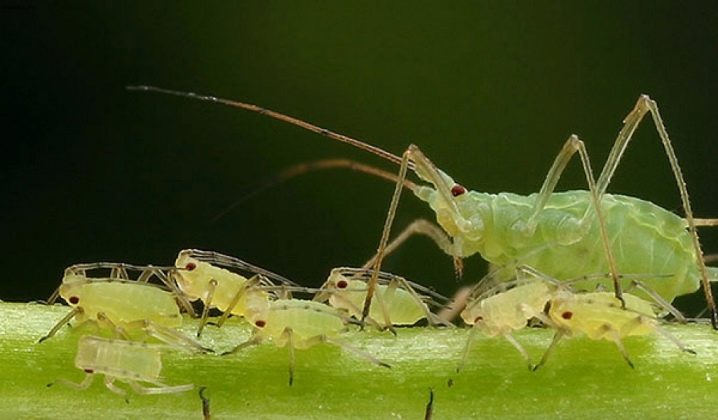
Root mite
An insect that destroys the underground part of the plant. To combat pests, some growers use folk remedies. Among them, the most effective are: processing the culture with soapy water, watering the flower with a solution of potassium permanganate. And also herbal decoctions and flower exposure under ultraviolet light are used.
If sparing means did not bring the desired result, it is recommended to destroy the pest with insecticide treatment.

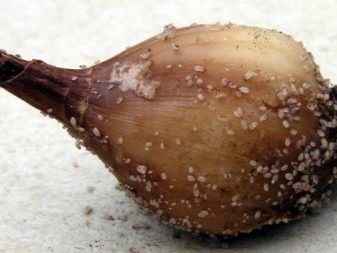
For more information on Bowden's nerin, see below.























The comment was sent successfully.